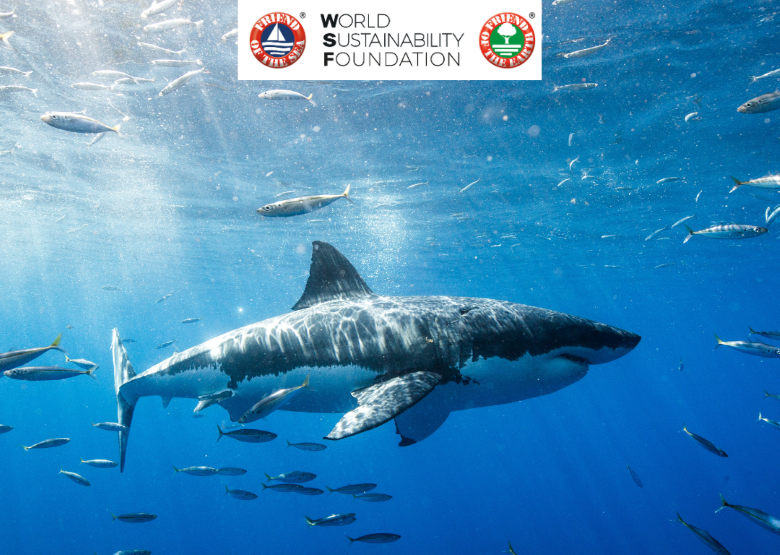To celebrate International Shark Day on July 14, the World Sustainability Foundation and Friend of the Sea® will take you into the world of the Shark
You can visit the Save the Sharks Campaign page to look at the initiatives taken by the WSF and Friend of the Sea® over the years
And happy International Shark Day to all!
Sharks facts
Sharks and rays have existed for over 420 million years. Actually, there are more than 500 species of sharks.
They are a group of fish characterized by a cartilaginous skeleton, five to seven-gill slits on the sides of the head, and pectoral fins that are not fused to the head. Covered with dermal denticles that protect their skin from damage and parasites and improve their fluid dynamics.
They also have numerous sets of replaceable teeth, in fact, they can replace as many as 10,000 teeth over their lifetime.
Sharks are top predators that play an important ecological role in marine ecosystems. Their health and well-being are therefore vital for maintaining healthy oceans — and by extension, vital for the communities that depend on the oceans for their food security and livelihoods.
Diet
The diet of sharks is very varied. First of all, let us state that humans are not part of their diet. Every year, there are about 5-15 fatalities due to sharks, and these are due to mistakes by the sharks themselves, who confuse us with other prey.
Threats
Sharks and rays are targeted by fisheries for their fins and gill plates, which fetch exorbitant prices due to their high demand as a delicacy in some Asian countries. There is also a market for shark meat, with European countries providing the biggest market. In addition to being targeted for their fins and meat, sharks often end up in fishing nets as incidental bycatch.
According to a recent TRAFFIC report that highlights major shark catchers, traders and affected species, the top 20 shark catching countries in the world caught more than 600,000 metric tons of sharks and rays each year between 2007-2017, with the top five countries — Indonesia, Spain, India, Mexico and the United States — catching a whopping 333,952 metric tons on average between them each year. It is estimated that up to 80 million sharks are caught globally each year.
According to the report, 16,177 metric tons of shark fin, valued at around USD294 million per year, were imported globally each year between 2000-2016, with 90% of these shark fin products being imported by four countries: Hong Kong SAR (9,069 mt/year), Malaysia (2,556 mt/year), mainland China (1,868 mt/year, and Singapore (1,587 mt/year). Brazil, Spain, Uruguay and Italy collectively accounted for an average of 57% of global shark meat imports during the ten year study period.
Environmental Consequences
These irresponsible and unsustainable fishing practices have resulted in alarming declines in a wide range of shark species. A quarter of the approximately 1,150 species of sharks and rays are currently in danger of extinction. Since sharks are slow growing, only reaching maturity relatively late in life, and have long reproductive cycles — often giving birth to less than a dozen pups every one to two years, they are particularly vulnerable to being overfished.
Despite conservation efforts, 17% of sharks and rays are currently listed as Critically Endangered, Endangered, or Vulnerable in the IUCN Red List, while 13% have a status of Near Threatened, and 47% are categorized as Data Deficient. Only 23% of all shark and ray species are listed under the category of Least Concern (Dulvy et al, 2014).
5 fun facts about sharks
- The whale shark (Rhincodon typus) is the largest fish in the world and can even exceed 18 meters in length.
- The dwarf lantern shark (Etmopterus perryi), is the smallest shark in the world, measuring just over 15 cm (6 inches) in length. Spotting it is pier rare, as it lives at depths between 283 and 439 meters and has been observed only a few times off the northern tip of South America.
- Female sharks are larger than males. This is to allow males to bite their pectoral fins to enable mating (which would be impossible if they were the same size)
- Males have two penises! No one knows exactly why they have two (which are technically called “claspers”), one theory holds that since the pairings are quite aggressive, there may be a risk of one of the penises breaking, and so having a spare one might be useful.
- The Greenland shark (Somniosus microcephalus) is the shark that can live the longest, it can live up to 400 years and reach sexual maturity around 150 years.




